#george armstrong custer
Text
I think I'm funny pt2
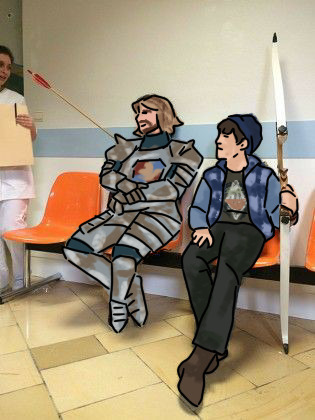

#slay#drawing#just crappy drawing thay brought me joy#natm fanart#night at the museum#art#digital sketch#natm#natm lancelot#night at The museum Lancelot#natm nicky#night at the museum nicky#natm lancelot drawing#natm nicky drawing#natm george custer#george Armstrong custer#george custer#natm George Armstrong custer#natm George custer drawing#meme
217 notes
·
View notes
Text

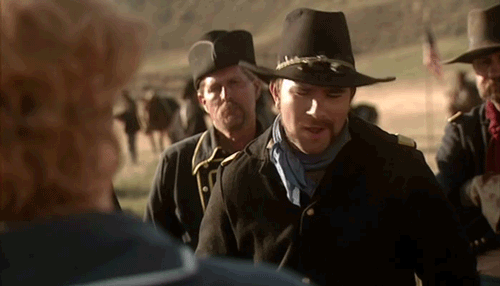

ROGER CLARK as Captain Weir in:
The Wild West (2007)
Season 1, Episode 1: "Custer's Last Stand"
⭐ Watch Custer's Last Stand on DailyMotion. ⭐
(GIF Set 1/6)
#roger clark#the wild west#custer's last stand#toby stephens#westerns#documentaries#bbc#general custer#george armstrong custer#irish actors#my edits#my gifs#tv series#historical events#us history#roger's filmography#roger's tv shows#battle of the little bighorn#lakota nation
65 notes
·
View notes
Text

Night at the Museum: Battle of the Smithsonian (2009, Shawn Levy)
23/12/2023
Night at the Museum: Battle of the Smithsonian is a 2009 film directed by Shawn Levy.
The film, starring Ben Stiller and Amy Adams, sequel to the film Night at the Museum, was released in cinemas on May 22, 2009 in the United States of America and in Italy. In 2014, its sequel entitled Night at the Museum: Secret of the Tomb was released, which once again saw Shawn Levy directing and Ben Stiller as the protagonist, alongside Robin Williams.
Two years have passed and Larry Dailey has left the Natural History Museum, where he worked as a night watchman, and entered the business world, becoming a major entrepreneur with his Dailey Devices. One day he returns to the museum driven by memories and discovers that all the wax statues will be packed up and transferred to the federal archive of the Smithsonian museum and replaced with interactive holograms. The only pieces not to leave the museum will be Teddy Roosevelt, Rex, Pharaoh Ahkmenrah and his magic board and some of the more popular characters.
The next evening Larry receives the phone call from Jedediah, the little cowboy, very scared: the capuchin mobkey Dexter, the night before, stole Ahkmenrah's table and everyone has come back to life in the Smithsonian, but they are held hostage by Ahkmenrah's evil older brother, Kahmunrah: the world's largest museum has come to life.
Larry decides to sneak into the museum archives and meets the proud and childish Kahmunrah: a series of clashes ensue in which, among others, George Armstrong Custer (who turns out to be just vain) and Amelia Earhart (ante litteram feminist) intervene.
The evil Kahmunrah then allies himself with Ivan the Terrible, Napoleon Bonaparte and Al Capone to then kidnap little Jedediah, who had facilitated Ottavio's escape from their prison, and lock him in an hourglass: in this way he forces Larry and Amelia to find the combination to be placed on the table, with which he wants to open the doors of the afterlife and unleash them on the world. Thanks to the help of a series of Einstein bobbleheads, the combination is found and the doors to the afterlife are opened from which bird demons arrive. In the meantime, Ottavio has asked for the intervention of the enormous statue of Abraham Lincoln, which sweeps away all of Kahmunrah's soldiers, who flee in panic and return to the afterlife.
Ben Stiller is Larry Dailey: Two years after the end of the first film, he abandoned his job as a night watchman at the Natural History Museum, founded the company Daley Devices and invented the Glow Flashlight along with other products. He returns to the museum and discovers that some artifacts had been moved to the federal archives of the Smithsonian museum and at this point he will have to deal with the evil pharaoh Kahmunrah.
Robin Williams as Teddy Roosevelt: he is Larry's best friend.
Amy Adams is Amelia Earhart: she is the wax statue of the famous pilot who flew over the Atlantic Ocean.
Hank Azaria as Kahmunrah: He is the main antagonist of the film.
Owen Wilson as Jedediah Smith: he is the main tritagonist of the film.
Steve Coogan as Gaius Octavius: The Roman general undertakes a rescue mission to free fellow cowboy Jedediah, who has been placed in an hourglass by Kahmunrah.
Mizou Peck is Sacagawea: Due to her transfer to the federal archives of the Smithsonian, she is forced to separate from her beloved Teddy Roosevelt but at the end of the final battle she returns home together with the old exhibits and sees the president again.
#Night at the Museum Battle of the Smithsonian#film#2009#shawn levy#ben stiller#amy adams#night at the museum#united states#italy#Sequel#Night at the Museum Secret of the Tomb#robin williams#american museum of natural history#smithsonian institution#holography#theodore roosevelt#Pharaoh#jedediah smith#George Armstrong Custer#amelia earhart#ivan the terrible#napoleon#al capone#Gaius Octavius#albert einstein#abraham lincoln#hank azaria#owen wilson#steve coogan#Mizuo Peck
9 notes
·
View notes
Text

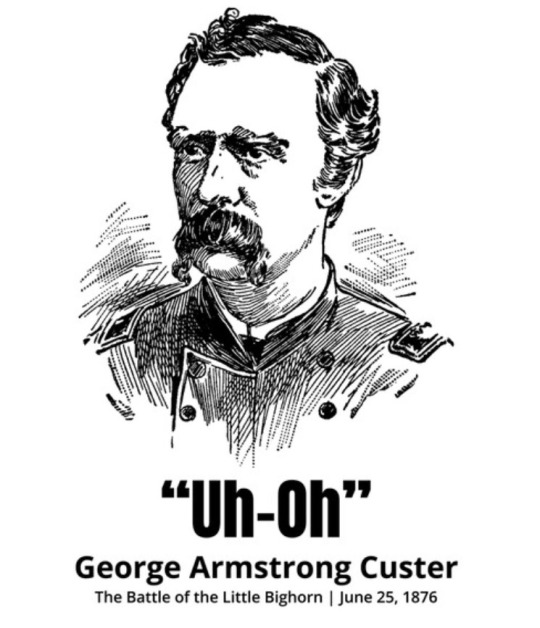
Y’all I can’t-
#american civil war#acw#american history#indian wars#history memes#George Armstrong Custer#Little Bighorn#is this okay to laugh at?#cuz I’m cackling
7 notes
·
View notes
Photo
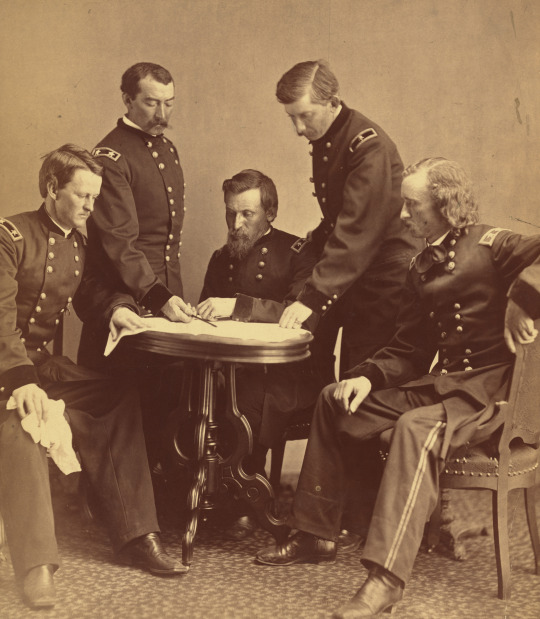
Photograph showing Generals Wesley Merritt, Philip Sheridan, George Crook, James William Forsyth, and George Armstrong Custer around a table examining a document. (x)
#american civil war#us civil war#philip sheridan#wesley merritt#george armstrong custer#george crook#james william forsyth#acw#history#i somehow just noticed that merritt has the SADDEST little mustache in this photo#why merritt get rid of it keep your baby face
8 notes
·
View notes
Text

On This Day: George Armstrong Custer GOT WHAT WAS COMING TO HIM
#happy death day#happy death day indeed#george armstrong custer#little big horn#on this date#on this day
0 notes
Text
1876-George Armstrong Custer
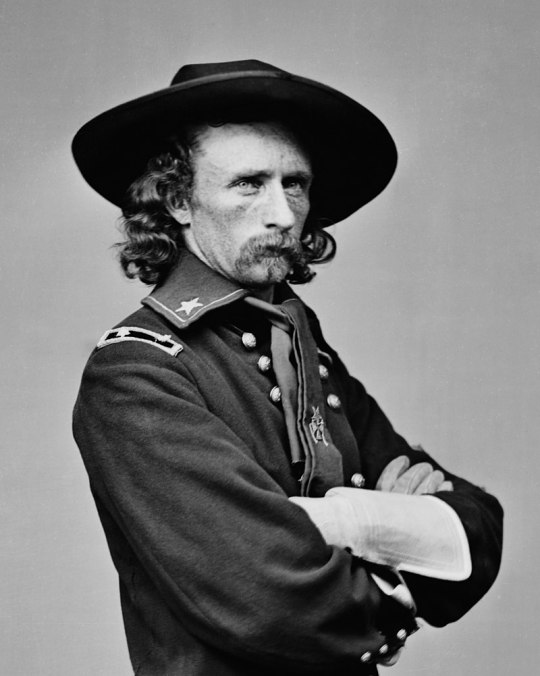
George Armstrong Custer (December 5, 1839 – June 25, 1876) was a United States Army officer and cavalry commander in the American Civil War[1] and the American Indian Wars.

After the Civil War, Custer was commissioned as a lieutenant colonel in the Regular Army and was sent west to fight in the Indian Wars, mainly against the Lakota and other Plains Peoples. On June 25, 1876, while leading the 7th Cavalry Regiment at the Battle of the Little Bighorn in Montana Territory against a coalition of Native American tribes,[4] he was killed along with every soldier of the five companies he led after splitting the regiment into three battalions. This action became known as "Custer's Last Stand"

Public response to the Great Sioux War varied in the immediate aftermath of the battle. Libbie Custer, Custer's widow, soon worked to burnish her husband's memory, and during the following decades Custer and his troops came to be considered heroic figures in American history. The battle, and Custer's actions in particular, have been studied extensively by historians.[15]Little Bighorn Battlefield National Monument honors those who fought on both sides.

0 notes
Text
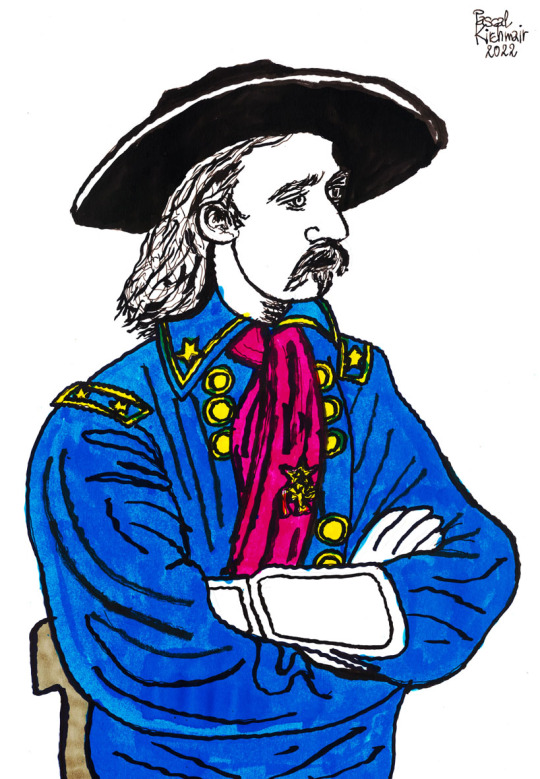
"General Custer", black and coloured inks on paper, 29,7 x 42 cm
ジョージ・アームストロング・カスター
#general custer#custer#george armstrong custer#pascal kirchmair#ilustracao#ilustracion#ilustração#illustrazione#illustratie#illustration#portrait#retrato#ritratto#desenho#dibujo#disegno#zeichnung#cartum#cartoon#caricatura#caricature#karikatur#porträt#portret#arte#art#kunst#little bighorn#tuschezeichnung#ink drawing
1 note
·
View note
Text
The Boy General I: George Armstrong Custer
The Boy General I: George Armstrong Custer
George Armstrong Custer became a character in American folklore for his actions in the Indian wars of the West. However, what is sometimes forgotten is his significant role in the American Civil War. Much of what he did out West mirrored his behavior while fighting the Confederates. Frankly, the boy general cut his teeth while fighting the Confederates. Custer proved his worth in two significant…

View On WordPress
0 notes
Text

Well. This book is just a bundle of emotions. I was a bit intimidated by it, but found it to be a manageable and enjoyable read.
The little girl deep inside me who grew up loving horses, Indians, and anything about the Old West thrilled at the stories about Crazy Horse. I was surprised at the great sadness I felt, the loss I felt, that I would never get the chance to ride into those lands when they were untamed and free. I'm envious of the men and women who first laid eyes on such beauty.
I was also surprised to find myself crying over Custer. He was kind of a joke in our family, a byword for stupidity with a hint of cowardice. I stand corrected. He might have been a bit... much... to anyone but his dear wife, but he was by no means a coward or stupid. I truly cried as he died, and my heart broke that two of his brothers, one nephew, and a brother in law died with him.
I wasn't surprised to cry over Crazy Horse, but it was sad to read of the pointless and traitorous death he faced after all the brave things he'd done.
I appreciated the insight Ambrose gave into the inability of the Indians to win the war. The way he graciously explained that no matter what they did, their very culture and way if life made it impossible for them to win.
The only negative thing I can say about this book was the appalling lack of respect Ambrose showed to women who chose to live lives poured our for their husbands, homes, and families. He may not have agreed, but they certainly didn't deserve the lack of respect he poured on them. Almost made me put the book down.
#feed the muse#reading#books#book review#crazy horse#custer#battle of little bighorn#George Armstrong Custer#Stephen E. Ambrose
1 note
·
View note
Text
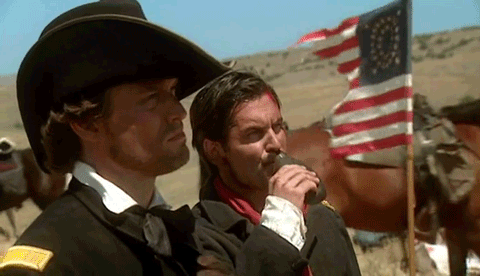
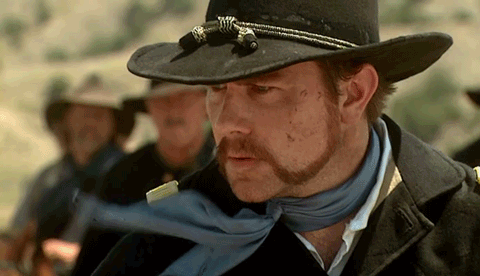

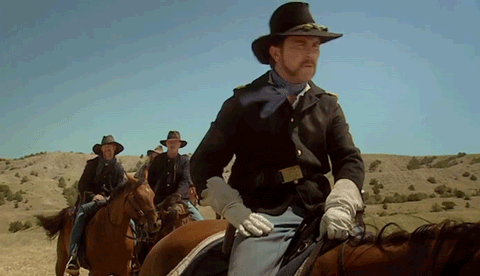
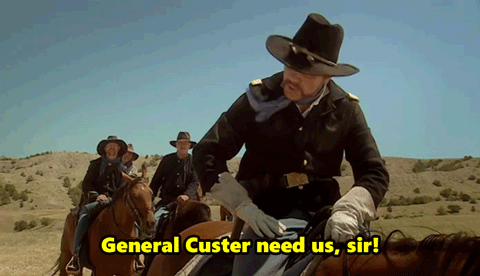

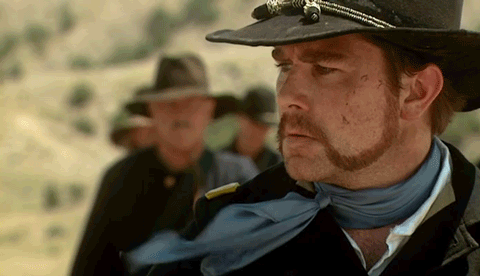
ROGER CLARK as Captain Wier in:
The Wild West (2007)
Season 1, Episode 1: "Custer's Last Stand"
⭐Watch Custer's Last Stand on Dailymotion ⭐
(GIF Set 5/6)
#roger clark#the wild west#custer's last stand#stephen billington#nigel whitney#bbc#general custer#westerns#us history#documentaries#george armstrong custer#battle of the little bighorn#roger's filmography#roger's tv shows#irish actors#lakota nation#historical events#the good ol' fashioned q
38 notes
·
View notes
Text
I think I'm funny pt...5?


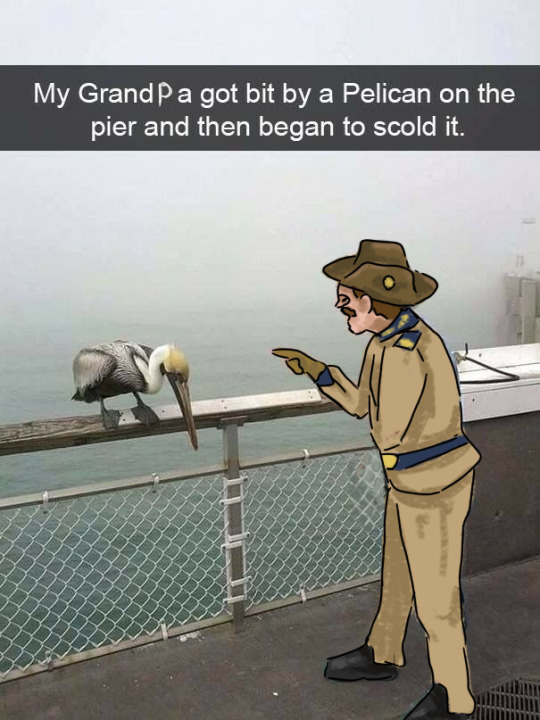
#slay#night at the museum#drawing#just crappy drawing thay brought me joy#natm#natm fanart#art#digital sketch#night at the museum teddy roosevelt#natm teddy roosevelt#teddy roosevelt#sacagawea drawing#natm sacagawea#night at the museum sacagawea#sacagawea#natm george custer drawing#natm george armstrong custer#natm george custer#general custer#night at the museum jedediah#jedediah smith#jedediah#jedediah natm#natm jedediah#railroad#sad
56 notes
·
View notes
Text
i just remembered that Custer is in Night at the Museum 2 and . why does this look like a still from a fucking Epic Rap Battles of History video KSHRNJHSN

#psy's no punctuation posts#custerposting#SERIOUSLY LIKE. FUCKIN#put the erb font GEORGE ARMSTRONG CUSTER over him and that's just an erb video#idk why it makes me laugh so hard but it does#yes i'm gonna fuckin watch NATM 2 to see him . i haven't seen that movie in a long time#idk why i even remembered he was in it#my guess going in... he's really dumb and an absolute nutcase#which is true. honestly. but still KRJKF#i would watch the shit out of an ERB with Custer though#(<-- unironic ERB fan in 2023)
8 notes
·
View notes
Text

𝐏𝐫𝐞𝐭𝐭𝐲 𝐍𝐨𝐬𝐞 🌻🌻
Pretty Nose : A Fierce and Uncompromising Woman War Chief You Should Know
Pretty Nose (c. 1851 – after 1952) was an Arapaho woman, and according to her grandson, was a war chief who participated in the Battle of the Little Bighorn in 1876.In some sources, Pretty Nose is called Cheyenne, although she was identified as Arapaho on the basis of her red, black and white beaded cuffs. The two tribes were allies at the Battle of the Little Bighorn and are still officially grouped together as the Cheyenne and Arapaho Tribes.
On June 25, 1876, a battalion of the 7th Cavalry, led by George Armstrong Custer, was wiped out by an overwhelming force of Lakota, Dakota, Northern Cheyenne, and Arapaho.
There are many stories that come from this most famous battle of the Indian Wars. However, the most overlooked account is of the women warriors who fought alongside their male counterparts.
Minnie Hollow Wood, Moving Robe Woman, Pretty Nose (pictured), One-Who-Walks-With-The-Stars, and Buffalo Calf Road Woman were among the more notable female fighters.
Pretty Nose fought with the Cheyenne/Arapaho detachment.
One-Who-Walks-With-The-Stars (Lakota) killed two soldiers trying to flee the fight.
Minnie Hollow Wood earned a Lakota war-bonnet for her participation, a rare honor.
Lakota Moving Robe Woman fought to avenge the death of her brother.
And Cheyenne Buffalo Calf Road Woman holds the distinction of being the warrior who knocked Custer off his horse, hastening the demise of the over-confident Lt. Colonel.
Pretty Nose's grandson, Mark Soldier Wolf, became an Arapaho tribal elder who served in the US Marine Corps during the Korean War. She witnessed his return to the Wind River Indian Reservation in 1952, at the age of 101.
#Pretty Nose#Lakota#Cheyenne/Arapaho#Woman War Chief#Battle of the Little Bighorn#1876#Other Lives#Past Times
55 notes
·
View notes
Text
On Dec 15th, we venerate Elevated Ancestor & Saint Tataηka Íyotake aka Chief Sitting Bull on the 133rd anniversary of his passing 🕊 [for our Hoodoos of First Nations descent]
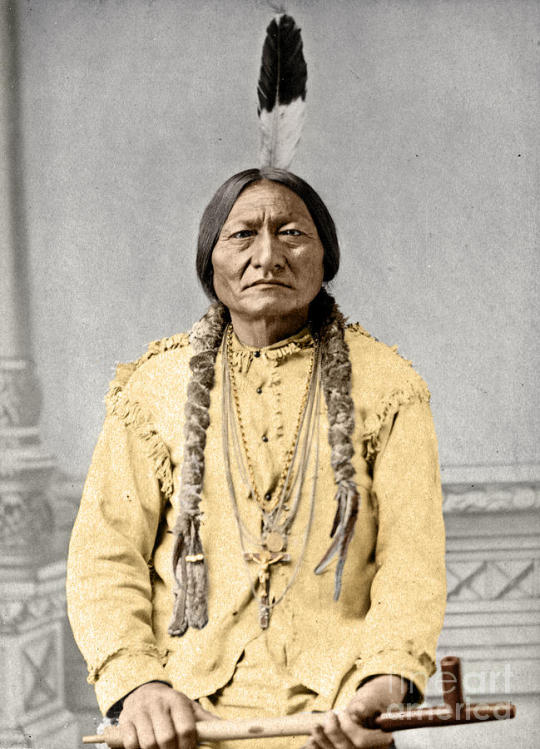
Sitting Bull, of the Hunkpapa Lakota, was a fierce political leader & holy man known to be a great father, husband, & friend to all. Under him, all the Lakota bands united for survival in the Northern Plains, as he spearheaded their resistance against European invasion. He was known for his legendary courage, unyielding defiance toward U.S. military power, & contemptuous of the many broken U.S. political promises.
Tatáŋka Íyotake was born to a prominent family of chiefs on the Grand River in present-day South Dakota at a place called, "Many Caches" - known for its abundant food storage pits. He was given his name, which described a buffalo bull sitting intractably on his haunches. This, he would grow live up to.
As a young man, Tatáŋka Íyotake joined two prominent groups within his community. He became a distinguished member of the Silent Eaters (a group concerned with tribal welfare) & leader of the Strong Heart Warrior Society. At 14, he joined his father & uncles on a raid against the Crow. Here, he first encountered White soldiers as the U.S. Army had mounted a broad campaign in retaliation for the Santee Rebellion in Minnesota, enchanting the Lakota had no affiliation with. That following year, in 1816, Tatáŋka Íyotake fought U.S. troops again at the Battle of Killdeer Mountain. Later, in 1865, he led a siege against the newly established Fort Rice in North Dakota. Widely respected for his bravery & insight, in 1868, Tatáŋka Íyotake became Head Chief of Lakota Nation.
By 1874, the stage for war between Sitting Bull & the US Army was set once an expedition led by General George Armstrong Custer confirmed gold had been discovered in the Dakota Territory’s the Black Hills, an area sacred to the Lakota bands. This land was decreed off-limits to white settlement by the Fort Laramie Treaty of 1868. Despite this ban, prospectors began a rush to the Black Hills. Once U.S. government efforts to purchase the Black Hills failed, the Fort Laramie Treaty was dismissed. The commissioner of Indian Affairs decreed that all Lakota not settled on reservations by January 31, 1876, would be considered hostile.
Rightfully so, Sitting Bull and his people held their ground. In March, 3 lines of federal troops invaded the area. Sitting Bull summoned the Lakota and their allies, the Cheyenne, & Arapaho to his camp on Rosebud Creek in Montana Territory. There, he led them in the sundance ritual, offering prayers to Wakáŋ Táŋka (Great Spirit). Sitting Bull slashed his arms 100 times in sacrifice for his people. During this ceremony, he shared that he'd had a vision. He saw soldiers falling into the Lakota camp like grasshoppers falling from the sky.
Inspired by this vision, the Oglala Lakota leader, War Chief Crazy Horse, set out for battle with a band of 500 warriors at the Battle of the Rosebud. To celebrate this victory, the Lakota moved their camp to the valley of the Little Bighorn River. They were joined by 3,000 more Native warriors who had abandoned the reservations to follow Sitting Bull.
On June 25th, the U.S. 7th Cavalry launched their attack under George Armstrong Custer. They rushed the Indian encampment as if in fulfillment of Sitting Bull’s vision. Yet they were severely outnumbered & thus defeated.
White outrage at this military catastrophe spurred thousands more cavalrymen to the area. Over the next year, they relentlessly pursued the Lakota bands.
Though many were forced into surrender, Sitting Bull remained defiant. In May 1877, he led his band to Canada, beyond the reach of the U.S. Army. When a U.S. General traveled north to audaciously offer him a pardon in exchange for settling on a reservation, Sitting Bull angrily dismissed him.
Four years later, in the wake of European invaders driving the Buffalo to near instinction, Sitting Bull found it nearly impossible to feed his people. So, he moved south to face surrender. On July 19, 1881, Sitting Bull’s young son handed his father’s rifle to the U.S. commanding officer of Fort Buford in Montana. Through this action, Sitting Bull hoped to teach his son “that he had become a friend of the Americans.” He also said, “I wish it to be remembered that I was the last man of my tribe to surrender my rifle.” He asked for the right to cross back & forth into Canada whenever he wished & for a reservation of his own on the Little Missouri River near the Black Hills. Instead, he was sent to Standing Rock Reservation. His warm reception there raised Army fears about a fresh uprising. So, Sitting Bull and his people were taken further down the Missouri River to Fort Randall. They were held as prisoners of war for nearly 2 more years.
Finally, on May 10, 1883, Sitting Bull rejoined his tribe at Standing Rock. The Indian Agent in charge of the reservation was determined to deny him any special privileges. And so, Sitting Bull was forced to work in the plantation fields. Yet when a delegation of U.S. Senators came to discuss opening part of the reservation to Whitea, he spoke forcefully, though futilely, against it.
In 1885, Sitting Bull was allowed to leave the reservation to join Buffalo Bill’s Wild West Show. He earned $50 a week for riding once around the arena. Sitting Bull also named his price for his autograph & picture. Unable to tolerate White society any longer, he stayed with the show for 4 months.
Returning to Standing Rock, Sitting Bull lived in a cabin near his birthplace on the Grand River; still rejecting the seeds of the colonialism - Christianity & giving up the traditional ways of life - as the reservation’s rules required. He did, however, send his children to a Christian school because he believed the next generation of Lakota would need the education of their oppressors to survive in the new world.
Here, he had another vision. He saw a meadowlark on a hillock beside him say,“Your own people, Lakotas, will kill you.” Nearly 5 years later, this vision would come to fruition.
In the fall of 1890, a Minŋecoŋjou Lakota named Kicking Bear came to Sitting Bull with news of the Ghost Dance, a ceremony that promised to rid the land of colonizers & restore the Indian way of life. Lakota had already adopted the ceremony at the Pine Ridge & Rosebud Reservations, and Indian Agents there had already called for troops to bring the growing movement under control.
At Standing Rock, the authorities feared Sitting Bull, still revered as a powerful spiritual leader, would join the Ghost Dancers as well. They sent 43 Lakota police officers to seize him. Before dawn on December 15th1890, the officers burst into Sitting Bull’s cabin & dragged him outside, where his followers were gathering to protect him. In the gunfight that followed, one of the Lakota police officers shot Sitting Bull in the head.
Today, Sitting Bull rests close to his birthplace near Mobridge, South Dakota. A granite shaft marks his grave.
"They claim this mother of ours, the Earth, for their own use, and fence their neighbors away from her, and deface her with their buildings and their refuse." - Sitting Bull.
We pour libations & give him💐 today as we celebrate him for his inspirational leadership, fearless figuring spirit, power in prayer, & his deep faith in Great Spirit.
Offering suggestions: a smoking pipe with tobacco, Lakota music, bison meat served with wild potatoes & prairie turnips
‼️Note: offering suggestions are just that & strictly for veneration purposes only. Never attempt to conjure up any spirit or entity without proper divination/Mediumship counsel.‼️
#hoodoo#hoodoos#atr#the hoodoo calendar#ancestor veneration#elevated ancestors#Sitting bull#Lakota Nation#Plains Indians#First Nations#Hunkpapa Lakota
39 notes
·
View notes
